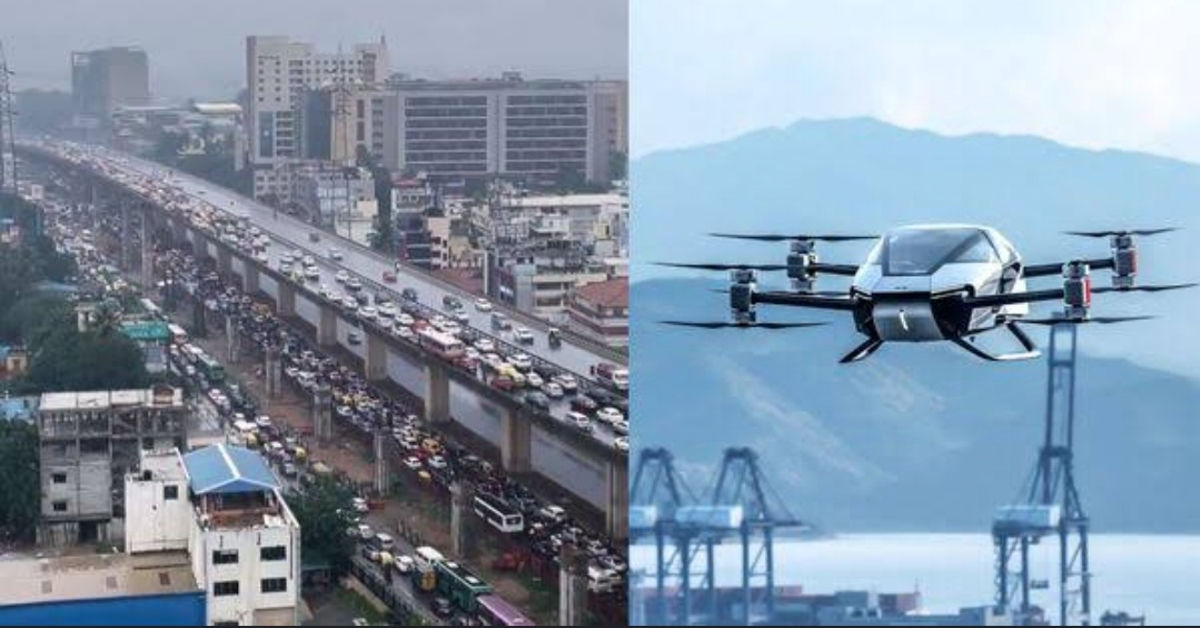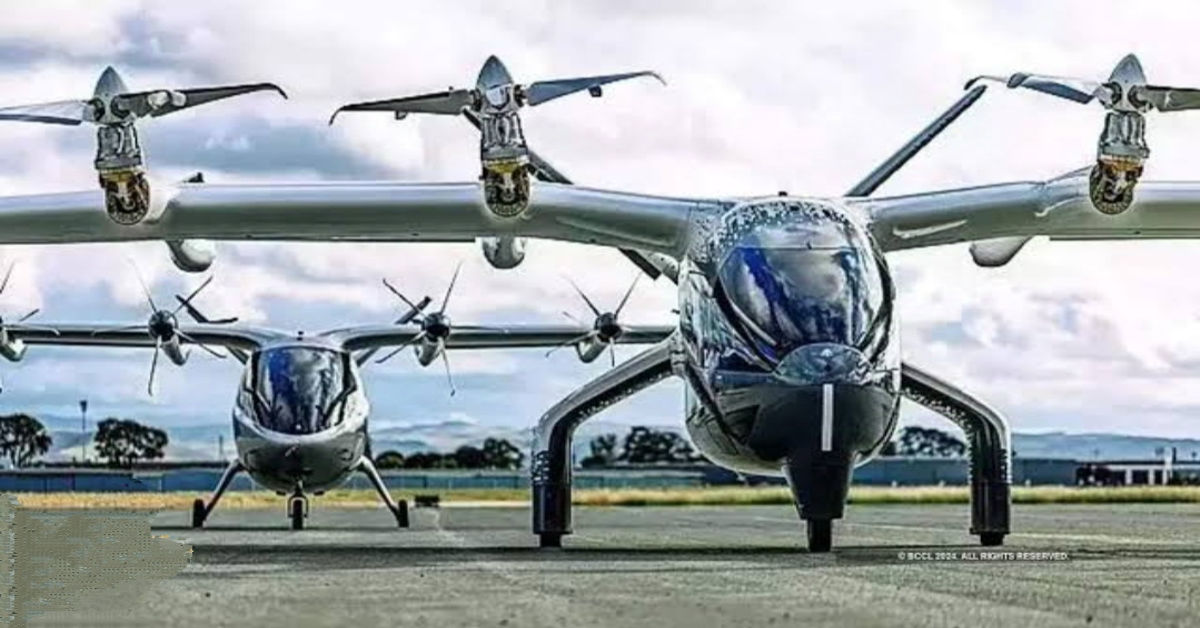Table of Contents
ToggleBengaluru to launch Air-Taxis
Introduction
Bengaluru, often referred to as the “Silicon Valley of India,” is not only a hub for technology and innovation but is also making significant strides in revolutionizing urban mobility. The announcement of air-taxis in the city is set to transform the way residents and visitors travel, particularly between the Kempegowda International Airport (KIA) and the bustling city center. With a fare of Rs. 1,700 and a travel time of just 19 minutes, this initiative aims to alleviate traffic congestion and offer a more efficient mode of transportation.

Background
Bengaluru has long been plagued by traffic woes, particularly during peak hours. The journey from the airport to the city can take anywhere from 1.5 to 2 hours, significantly hindering the overall travel experience. As the city continues to grow, with an influx of both tourists and tech professionals, the need for innovative transportation solutions has become increasingly urgent. Enter the air-taxi service—an idea that blends technology with convenience.
The Concept of Air-Taxis
Air-taxis, or eVTOLs (electric Vertical Take-Off and Landing vehicles), represent a new frontier in transportation. These aircraft are designed to operate autonomously, significantly reducing the need for traditional taxi services and providing a quicker, more efficient alternative. With advancements in drone technology and electric aviation, air-taxis promise to be a sustainable option for urban commuting.
The Economic Impact
The introduction of air-taxis in Bengaluru is poised to have substantial economic implications. Firstly, it is expected to create jobs, both directly in the operation of these services and indirectly through associated industries such as maintenance, training, and support services. Secondly, by improving the connectivity between the airport and the city, the initiative can attract more business travelers, boosting local commerce and tourism.
Environmental Considerations
One of the primary advantages of air-taxis is their potential for reduced carbon emissions. As electric vehicles, eVTOLs can significantly lower the environmental impact compared to traditional gas-powered taxis and shuttles. This aligns with Bengaluru’s commitment to sustainable urban development and positions the city as a leader in environmentally friendly transportation.
Safety and Regulations
Safety is paramount when it comes to air travel. The introduction of air-taxis will necessitate rigorous regulatory frameworks to ensure passenger safety and air traffic management. This includes certification of aircraft, pilot training, and establishing no-fly zones in urban areas. Collaboration with regulatory bodies like the Directorate General of Civil Aviation (DGCA) will be crucial to address these challenges.
Infrastructure Development
To support air-taxi operations, Bengaluru will need to invest in infrastructure development. This includes establishing vertiports—designated landing and take-off zones for air-taxis—strategically located near key points of interest in the city. Additionally, integrating this service with existing transportation systems, such as buses and the metro, will enhance accessibility for passengers.
User Experience
The user experience of air-taxis will play a significant role in their adoption. Seamless booking processes through mobile applications, transparent pricing, and efficient boarding procedures will be essential for attracting customers. Providing a comfortable, safe, and quick journey will further encourage usage, making air-taxis a preferred choice for travelers.
Public Reception and Challenges
While the prospect of air-taxis is exciting, public reception may vary. Concerns about noise pollution, safety, and air traffic congestion could impact acceptance. Public awareness campaigns, emphasizing the safety measures in place and the environmental benefits, will be crucial in garnering support from the community.
Future Prospects
The launch of air-taxis in Bengaluru is just the beginning. If successful, this initiative could pave the way for similar services in other cities across India and even internationally. Furthermore, advancements in technology could lead to the development of larger air-taxis capable of carrying more passengers, further enhancing urban mobility solutions.
The Need for Air-Taxis in Bengaluru
Bengaluru’s rapid growth has led to significant traffic congestion, making commuting a challenge for many residents. The city, home to over 12 million people, is one of the fastest-growing metropolitan areas in India. The Kempegowda International Airport, located about 35 kilometers from the city center, serves millions of passengers annually, contributing to the already congested roadways. The introduction of air-taxis could be a game changer, offering a viable solution to these persistent problems.
Traffic Congestion: A Growing Concern
The increasing number of vehicles on Bengaluru’s roads has resulted in some of the longest commute times in India. The journey from the airport to the city can take up to two hours during peak traffic, leading to frustration among travelers and a negative impact on productivity. The air-taxi service aims to provide a reliable alternative that can bypass ground traffic, reducing travel times significantly.

Read this also : Bajaj Auto’s Q2 Performance: Analyzing the 10% Stock Crash
Air-Taxi Technology
Electric Vertical Take-Off and Landing (eVTOL) Vehicles
Air-taxis are typically based on eVTOL technology, which allows them to take off and land vertically, similar to helicopters. These vehicles are designed to be quieter, safer, and more efficient than traditional aircraft. With the growing focus on sustainable transportation, eVTOLs utilize electric propulsion systems, reducing emissions and noise pollution.
Autonomous Flight
Many air-taxi models are designed to operate autonomously, using advanced algorithms and sensors for navigation and obstacle avoidance. This technology enhances safety and efficiency, allowing for precise landings and takeoffs. Human pilots may still be involved in some operations, particularly during the initial stages of service rollout.
Economic and Social Implications
Job Creation
The launch of air-taxis is expected to create numerous jobs across various sectors. From aircraft maintenance technicians to flight operations personnel, a variety of roles will be essential to support this new mode of transportation. Furthermore, related industries, such as tourism and hospitality, are likely to benefit from increased travel options.
Boost to Local Businesses
Improved connectivity between the airport and the city center can lead to increased business opportunities. Faster travel times can encourage business travelers to visit Bengaluru more frequently, benefiting local hotels, restaurants, and service providers. This economic boost can help sustain the city’s growth and development.
Environmental Benefits
Reducing Carbon Footprint
As urban areas grapple with climate change and air quality issues, air-taxis present a cleaner alternative to traditional taxis and cars. With electric propulsion, these vehicles can significantly reduce greenhouse gas emissions, contributing to Bengaluru’s sustainability goals.
Noise Pollution
Traditional helicopters and aircraft are often associated with high noise levels, which can be disruptive to urban life. In contrast, many eVTOLs are designed to operate quietly, minimizing disturbances in residential and commercial areas.
Safety Protocols and Regulations
Regulatory Framework
The introduction of air-taxis necessitates a comprehensive regulatory framework to ensure safety. The Directorate General of Civil Aviation (DGCA) in India will need to establish guidelines for air-taxi operations, including flight paths, safety protocols, and pilot qualifications.
Safety Features
Modern air-taxis come equipped with multiple safety features, including redundant systems for critical components and advanced avionics for navigation. Continuous monitoring of air traffic and real-time data sharing with ground control will also enhance safety.
Infrastructure Development
Vertiports
To accommodate air-taxis, Bengaluru will require specialized infrastructure known as vertiports. These facilities will serve as takeoff and landing zones and may include amenities for passengers, such as lounges and booking kiosks. Strategically located near major business districts, hotels, and transport hubs, vertiports will facilitate seamless connections for passengers.
Integration with Public Transport
For air-taxis to be fully effective, they must be integrated with existing public transport systems. This includes connecting vertiports to metro stations, bus terminals, and other forms of transport, enabling passengers to complete their journeys with ease.
User Experience and Technology Integration
Booking Systems
To attract users, the air-taxi service must offer a user-friendly booking experience. Mobile applications that allow passengers to schedule flights, track availability, and make payments seamlessly will be essential. Real-time updates on flight status and expected arrival times will further enhance the user experience.
Comfort and Convenience
Air-taxis will need to prioritize passenger comfort, providing spacious cabins, climate control, and amenities similar to those found in premium taxi services. Ensuring a pleasant journey will be key to encouraging regular use.
Public Perception and Engagement
Addressing Concerns
Public perception will play a crucial role in the success of the air-taxi initiative. Concerns related to safety, noise, and air traffic management must be addressed through transparent communication and community engagement.
Building Trust
Regular public information campaigns, demonstrations, and community meetings can help build trust among potential users. Engaging local communities in discussions about air-taxi operations can foster a sense of ownership and acceptance.
Future Prospects and Scalability
Expansion Beyond Bengaluru
If successful, the air-taxi initiative in Bengaluru could serve as a model for other Indian cities facing similar challenges. As technology advances and public acceptance grows, air-taxi services may expand to regions such as Mumbai, Delhi, and Hyderabad.
Innovations in Air Mobility
The future of urban air mobility is promising, with ongoing innovations in battery technology, autonomous flight systems, and materials science. These advancements could lead to more efficient and affordable air-taxi services, ultimately reshaping how people move within cities.

Conclusion
The introduction of air-taxis in Bengaluru marks a significant step toward modernizing urban transportation. By addressing traffic congestion, enhancing connectivity, and promoting sustainability, this initiative has the potential to transform the way residents and visitors navigate the city. While challenges remain, the benefits of air-taxis are clear, and with the right infrastructure, regulations, and public engagement, Bengaluru could become a leader in the future of urban mobility. As this innovative service takes flight, the world will be watching to see how it unfolds, potentially setting the stage for a new era in transportation.

[…] Read This Post Also : Bengaluru to launch Air-Taxis. […]